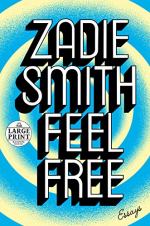|
This section contains 415 words (approx. 2 pages at 400 words per page) |

|
Feel Free Summary & Study Guide Description
Feel Free Summary & Study Guide includes comprehensive information and analysis to help you understand the book. This study guide contains the following sections:
This detailed literature summary also contains Topics for Discussion on Feel Free by Zadie Smith.
The following version of this book was used to create this study guide: Smith, Zadie. Feel Free. Penguin Press, 2018.
Feel Free, a collection of essays and writings published by Zadie Smith in recent years, is divided into five parts: “In the World,” “In the Audience,” “In the Gallery,” “On the Bookshelf,” and “Feel Free.” “In the World” primarily tackles recent political questions, including the U.K.’s vote to leave the European Union, the planned demolition of libraries in London, rising xenophobia and hostility in British culture, climate change and multiculturalism.
“In the Audience” places Smith in the role of a critic and spectator, and shows her engaging with popular culture forms, such as television, film, music and comedy. These essays include a profile of Jay-Z, who Smith likens to an “elder statesman” (72), and a profile of Keegan Michael-Key and Jordan Peele, the creators of the sketch comedy show Key & Peele, as well as a more personal essay about Smith’s evolving relationship to Joni Mitchell’s music.
“In the Gallery” showcases Smith’s relationship to visual art. In this section, Smith discusses the first purchase of art she ever made, muses on the importance and meaning of camp, and writes about Balthasar Denner’s painting, "Alte Frau." “In the Gallery” concludes with Smith’s analysis of Jordan Peele’s summer hit film, “Get Out,” which she juxtaposes with Dana Schultz’s controversial painting of Emmett Till.
In “On the Bookshelf,” the longest section of Feel Free, Smith reviews and reflects on a number of books. Some of these books, such as "The Buddha of Suburbia" by Hanif Kureishi, have been inspirational to her and her writing. A number of other books are ones that she reviewed for Harper’s Magazine. A handful of the pieces in “On the Bookshelf” also reflect on her own writing, such as “Notes on NW” about the literary influences behind "NW" and “The I Who Is Not Me,” about Smith’s growing acceptance of the first person tense.
The final section, “Feel Free,” shifts the conversation towards larger and more scattered questions about personhood, joy versus pleasure, and gardens. The section begins with an analysis of the objectification of Justin Bieber and ends with Smith’s belief that joy, unlike pleasure, is a combination of “terror, pain and delight” (429). The collection of essays ends with Smith’s surprise that, unlike animals, humans tend to choose the more complex feeling of joy over the simpler feeling of pleasure.
Read more from the Study Guide
|
This section contains 415 words (approx. 2 pages at 400 words per page) |

|



